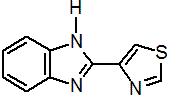|
thiabendazole
Fungicide
FRAC 1, B1; benzimidazole

NOMENCLATURE
Common name thiabendazole (BSI, E-ISO, (m) F-ISO, BAN, JMAF)
IUPAC name 2-(thiazol-4-yl)benzimidazole; 2-(1,3-thiazol-4-yl)benzimidazole
Chemical Abstracts name 2-(4-thiazolyl)-1H-benzimidazole
CAS RN [148-79-8] EEC no. 205-725-8 Development codes MK 360 (Merck & Co.)
PHYSICAL CHEMISTRY
Mol. wt. 201.3 M.f. C10H7N3S Form Off-white powder. M.p. 297-298 °C V.p. 4.6 ´ 10-4 mPa (25 °C) KOW logP = 2.39 (pH 7) Henry 2.7 ´ 10-8 Pa m3 mol-1 S.g./density 1.3989 Solubility In water 0.16 (pH 4), 0.03 (pH 7), 0.03 (pH 10) (all in g/l, 20 ºC). In n-heptane <0.01, xylene 0.13, methanol 8.28, 1,2-dichloroethane 0.81, acetone 2.43, ethyl acetate 1.49, n-octanol 3.91 (all in g/l, 20 ºC). Stability Hydrolytically stable; aqueous photolysis DT50 29 h (pH 5). pKa pKa1 4.73, pKa2 12.00
COMMERCIALISATION
History Fungicidal properties reported by H. J. Robinson et al. (J. Invest. Dermatol., 1964, 42, 479) and T. Staron & C. Allard (Phytriatr.-Phytopharm., 1964, 13, 163) and its systemic properties in plants by D. C. Erwin et al. (Phytopathology, 1968, 58, 860). Merck & Co. originally introduced it, as an anthelmintic in 1963 and, from 1969-77, as an agricultural fungicide on citrus, bananas, pome fruit, avocados, mangoes, papaya and potatoes. Now owned by Syngenta. Patents US 3017415 Manufacturers Sundat; Syngenta
APPLICATIONS
Biochemistry Inhibits mitosis by binding to tubuline and thus severely impairs fungal growth and development Mode of action Systemic fungicide with protective and curative action. Thiabendazole forms a protective deposit on the treated surface of fruit and tubers. Uses As a mainly post-harvest fungicide for the control of Aspergillus, Botrytis, Ceratocystis, Cercospora, Cladosporium, Colletotrichum, Corticium, Diaporthe, Diplodia, Fusarium, Gibberella, Gloeosporium, Oospora, Penicillium, Phoma, Podosphaera leucotricha, Rhizoctonia, Sclerotinia, Septoria, Thielaviopsis, Venturia inaequalis, Verticillium spp., etc., in avocados (2 g/l), bananas (0.2-0.4 g/l), chicory, citrus fruit (2.2 g/l), mangoes (2 g/l), mushrooms, ornamentals, pome fruit (1.1 g/l) and potatoes (30 g/ton). Also used for seed treatment and stem injection application. Formulation types SC; SL; TB; WP. Selected products: 'Mertect' (post-harvest, foliar) (Syngenta); 'Tecto' (post-harvest, foliar) (Syngenta); 'Decco' (post-harvest) (Cerexagri); 'Hykeep' (Agrichem Int.); 'LSP' (Gustafson); mixtures: 'Vincit' (+ flutriafol+ imazalil) (Cheminova)
OTHER PRODUCTS
'Storite' (post-harvest) (Syngenta); 'Chem-Tk' (Agri-Chem); 'Xédazole' (post-harvest) (Xeda) mixtures: 'Extratect' (+ imazalil) (seed) (Syngenta); 'Storite SS' (+ tecnazene) (post-harvest) (Syngenta); 'Fortiva' (+ thiram+ metalaxyl) (seed) (Limagrain); 'Granol Plus' (+ gamma-HCH+ maneb) (Wilbur-Ellis); 'Granox' (+ maneb) (Agriliance); 'Hy-TL' (+ thiram) (Agrichem Int.); 'sHYlin' (+ thiram) (Agrichem Int.); 'Vincit FS' (+ flutriafol+ imazalil) (Stähler, Cheminova); 'Vitaflo Extra' (+ carboxin+ imazalil) (Crompton); 'Vitavax Extra' (+ carboxin+ imazalil) (Crompton) Discontinued products: 'Apl-Luster' * (Elf Atochem); 'Bioguard' * (Merck & Co.); 'Ceratotect' * (MSD Agvet); 'Radinex' * (BASF) mixtures: 'Apron Combi' * (+ thiram+ metalaxyl) (seed) (Novartis); 'Ferrax' * (+ ethirimol+ flutriafol) (seed) (Syngenta, Cheminova); 'Ascot' * (+ thiram) (Ciba); 'Hy-Vic' * (+ thiram) (Agrichem Int.); 'Vitavax-Plus' * (+ carboxin) (Uniroyal)
ANALYSIS
Product analysis is by hplc (CIPAC Handbook, 1992, E, 211). Residues in food crops determined by hplc or spectrofluorimetrically. Details are available from Syngenta
MAMMALIAN TOXICOLOGY
Reviews MAFF Report No. 54 (1992); JECFA 48 (Geneva, 1997; see part 2 of Bibliography), JMPR 1997 (Lyon). "Review report for the active substance thiabendazole", EU document 7603/VI/97-final, 22 March 2001. Oral Acute oral LD50 for mice 3600, rats 3100, rabbits ³3800 mg/kg. Skin and eye Acute dermal LD50 for rabbits >2000 mg/kg. Non-irritating to eyes and skin (rabbits). Not a skin sensitiser (guinea pigs). Inhalation LC50 for rats >0.5 mg/l. NOEL In 2 y feeding trials, rats receiving 10 mg/kg daily showed no ill-effects. ADI (JECFA, JMPR, EU) 0.1 mg/kg b.w. Toxicity class WHO (a.i.) U; EPA (formulation) III EC classification N; R50, R53
ECOTOXICOLOGY
Birds Acute oral LD50 for bobwhite quail >2250 mg/kg. Dietary LC50 (5 d) for bobwhite quail and mallard ducks >5620 mg/kg diet. Fish LC50 (96 h) for bluegill sunfish 19, rainbow trout 0.55 mg/l. Daphnia EC50 (48 h) 0.81 mg/l. Algae EC50 (96 h) for Selenastrum 9 mg/l; NOEC for Selenastrum 3.2 mg/l. Other aquatic spp. LC50 (96 h) for shrimps 0.34 mg/l, oysters >0.26 mg/l. Bees Not toxic to bees. Worms LC50 >500 mg/kg soil. Other beneficial spp. Harmless to Aleochara, Typhlodromus and Chrysoperla; slightly harmful to Aphidius.
ENVIRONMENTAL FATE
Animals When administered orally, thiabendazole is rapidly absorbed; up to 90% of the total dose is eliminated (about 65% in urine and 25% in faeces) within 24 h, in both sexes. The compound is rapidly distributed to tissues, with highest levels found in the heart, lungs, spleen, kidneys, and liver. The compound is essentially completely cleared from the body within 7 days in both dose groups. Thiabendazole undergoes hydroxylation at the 5-position. Plants The residue on all crops treated pre- or post-harvest is parent thiabendazole. Soil/Environment Soil DT50 >1 y (1 mg/kg, harsh conditions), 33 d (20 °C, 40% MWC, 0.1 mg/kg soil), 120 d (20 °C, 40% MWC, 1 mg/kg soil). Aqueous photolysis DT50 29 h (pH 5).
|